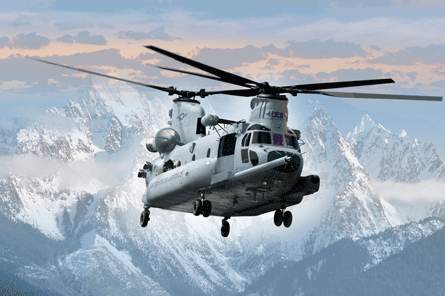The US Air Force has begun evaluating three bids for its $15 billion combat search and rescue (CSAR-X) helicopter contract, although the scheduled award date in April is subject to review by President Barack Obama's administration.
The CSAR-X contract has been in competition for about three years. The USAF's original award to Boeing in November 2006 was overturned by the US Government Accountability Office (GAO), and losing bidders Lockheed Martin/AgustaWestland and Sikorsky also successfully protested against the air force's second evaluation process.
A third round of bidding finally began last November, with the deadline for proposals ending on 20 January, 2h after Obama took office.
All three original bids - Boeing's HH-47 Chinook, the Lockheed/AgustaWestland's US101 and Sikorsky's HH-92 - remain in the competition. However, the USAF has adjusted the disputed evaluation criteria in at least three areas.
 |
|---|
© Boeing |
Perhaps the most controversial change affects how lifecycle costs will be evaluated. In the first competition, the USAF distrusted long-term estimates for maintenance costs by the three bidders. Instead, it used data from its current Sikorsky HH-60 fleet as the baseline, a decision that Lockheed and Sikorsky successfully contested.
Instead, the USAF allowed the three teams to submit unique cost estimates for maintenance man-hours. But those long-term estimates also will be weighted lower in the USAF's evaluation than more near-term projections - a decision that Sikorsky openly opposes.
"I can't understand that," says John Pacelli, Sikorsky's business acquisition manager for CSAR-X. "We're talking about actual manpower and the number of people and their salaries to maintain and sustain the platform. That's not something that's going to change over time."
But Sikorsky is encouraged that the USAF asked bidders to elaborate about the survivability and vulnerability aspects of their aircraft. With the HH-92 being both the smallest and most modern design in the competition, Pacelli believes a stronger emphasis on crashworthiness and infrared signature will improve Sikorsky's chances.
However, Boeing believes that its HH-47 remains the strongest candidate in the field. "We really believe we're where we were 2.5 years ago - as a strong contender - and I think this will be the vehicle the customer chooses again," says Phil Dunford, vice-president and general manager for Boeing rotorcraft.
Lockheed's team confirmed submitting a bid, but declined requests for interviews.
In the first competition, the USAF cited the larger size of the HH-47 as a major factor in its selection decision. But Sikorsky thinks economics could play the decisive factor in the third round.
"Particularly in these difficult times we feel that we have the right vehicle that meets or exceeds the technical requirements," Pacelli says. "And when you couple that with a proposal that can save you billions of dollars on the cost side of the equation you have a really good chance."
Source: Flight International























